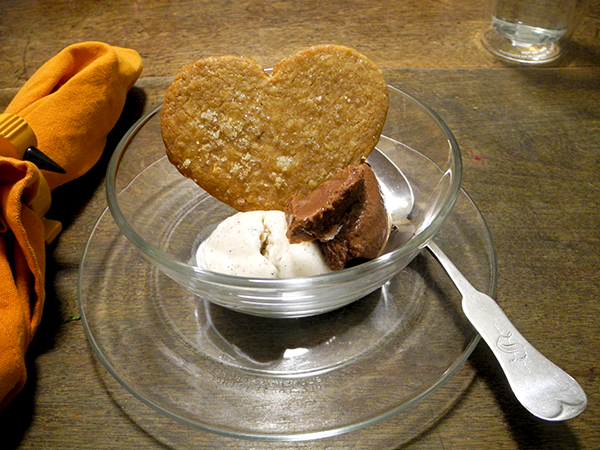Even if it weren’t St. Valentine’s day, it might have been possible to spot a theme running through this meal. I don’t want to go into an analogy of its physical elements, to protect the squeamish, but the color red – and hearts shapes – were important parts of the conceit.
The meal began with one of my favorite things, from the sea, another of those treats which I suppose I could put together myself, with a great deal of labor, and perhaps an occasional success, but which I enjoy prepared by experts.
- octopus carpaccio (sliced, pressed octopus), less than 3 ounces altogether, from The Lobster Place, drizzled with a little juice from a tiny lemon-lime grown locally by David of Fantastic Gardens of Long Island, and a little very good olive oil
- micro kale greens from Lucky Dog Organic Farm
- slices of a small Bien Cuit baguette from Forager’s Market
- the wine was a really super Spanish (Penedès) sparkling rosé (it was Valentine’s Day!), Castellroig Cava Brut Rosat
Avoiding the subject of hearts for a moment, and looking at this entrée, I’m thinking I might have figured out why this is called a ‘flatiron steak’ (a new, increasingly-prized, and quite singular shoulder cut of beef which is sliced by the butcher into 2 flat steaks, to remove the heavy connective tissue) , except that its companion was definitely not shaped like an antique iron.
It seems that I’m not the only one to have speculated about the name; others have tried to track down the story, including this sleuth, but I think with less than full success.
I chose the 2 steaks at Dickson’s Farmstand Meats, for their perfect size, and at the suggestion of Philip, one of the shop’s knowledgeable butchers. They were delicious, more tasty than more familiar, and pricier cuts that are often preferred for their ability to melt in your mouth (not a feature that compels me).
- two flat iron steaks (totaling 14 ounces) from Dickson’s Farmstand, brought to room temperature, dried with paper towels, scattered with a little sea salt, pan-grilled for about 4 minutes on each side, a little more salt and freshly-ground telicherry pepper added to both sides after each had been cooked, removed to warm plates, drizzled with a little juice from another local tiny lemon-lime, sprinkled with chopped winter savory from Stokes Farm, and a little olive oil
- about half a pound of tiny La Ratte potatoes (the size of small-ish olives) from Berried Treasures Farm, scrubbed, dried, tossed with olive oil, thyme sprigs from Forager’s, salt, and pepper, scattered on a seasoned, medium-size Pampered Chef oven pan in a 375º-400º oven for about 20 minutes, removed, arranged on the plates and tossed with chopped parsley from Eataly
- some beautiful kale from Alewife Farm, sautéed in olive oil in which 3 split medium cloves of garlic from Keith’s Farm had first been allowed to sweat for a few minutes and begun to brown, seasoned with salt, pepper, and a dash of olive oil
- the wine with the steak was a magnificent, middle-age Spanish (Rioja) red, Viña Ardanza Reserva La Rioja DOC Alta S.A. 2005 [that link is to the producer’s site discussing the 2007 vintage; we’ve had our 2005 for years, and Alta S.A. may now consider it extinct]
It’s not red, but it is in the shape of a heart, and its totally ‘nutty’ (specifically, pine nuts and hazelnuts).
- two crispy pine nut and hazelnut cookies from Foragers Market, served with a little Ciao Bella ‘Madagascar Vanilla’ gelato and some ‘Dark Cocoa’ sorbetto, also from Ciao Bella
- the music before and then throughout a part of the meal was Mozart’s ‘The Rake Punished, or Don Giovanni’, Yannick Nézet-Séguin conducting the Mahler Chamber Orchestra, with Ildebrando D’Arcangelo, Luca Pisaroni, Diana Damrau, Joyce DiDonato, Rolando Villazón, Mojca Erdmann, and Vocalensemble Rastatt
- when the opera had finished, well before we had, I suggested one Valentine’s Day tale be followed with another, the wonderful Stravinsky-Auden-Kallman collaboration, ‘The Rake’s Progress‘, like the Mozart-Da Ponte work, a dramma giocoso, or opera buffa, in the composer’s mid-20th-century neo-classical style, which brought it even closer to the neo-classical age of the eighteenth (and they both have sassy upbeat epilogues!); we heard John Eliot Gardner’s production, with the London Symphony Orchestra, Bryn Terfel, Ian Bostridge, Anne Sofie von Otter, Deborah York, and The Monteverdi Choir


